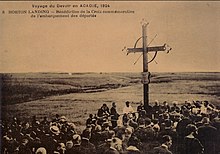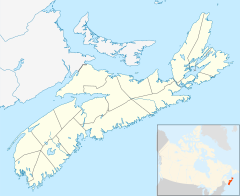Grand-Pré, Nova Scotia: Difference between revisions
Hantsheroes (talk | contribs) No edit summary |
Hantsheroes (talk | contribs) No edit summary |
||
| Line 9: | Line 9: | ||
|caption = Grand-Pré in [[Nova Scotia]] |
|caption = Grand-Pré in [[Nova Scotia]] |
||
}} |
}} |
||
| ⚫ | |||
'''Grand-Pré''' is a [[Canada|Canadian]] rural community in [[Kings County, Nova Scotia|Kings County]], [[Nova Scotia]]. Its French name translates to "Great Meadow" and the community lies at the eastern edge of the [[Annapolis Valley]] several kilometres east of the town of [[Wolfville, Nova Scotia|Wolfville]] on a peninsula jutting into the [[Minas Basin]], framed by the Gaspereau and [[Cornwallis River]]s. |
'''Grand-Pré''' is a [[Canada|Canadian]] rural community in [[Kings County, Nova Scotia|Kings County]], [[Nova Scotia]]. Its French name translates to "Great Meadow" and the community lies at the eastern edge of the [[Annapolis Valley]] several kilometres east of the town of [[Wolfville, Nova Scotia|Wolfville]] on a peninsula jutting into the [[Minas Basin]], framed by the Gaspereau and [[Cornwallis River]]s. |
||
==History== |
==History== |
||
| ⚫ | |||
Grand-Pré was founded by [[Acadian]] settlers who travelled east from [[Samuel de Champlain|Champlain]]'s original settlement in Port-Royal [[Annapolis Royal]] in 1680. The settlement grew and developed great expanses of tidal marsh as productive farmland. |
Grand-Pré was founded by [[Acadian]] settlers who travelled east from [[Samuel de Champlain|Champlain]]'s original settlement in Port-Royal [[Annapolis Royal]] in 1680. The settlement grew and developed great expanses of tidal marsh as productive farmland. |
||
=== Queen Anne's War === |
=== Queen Anne's War === |
||
[[File:BenjaminChurchNewYorkPublicLibraryStephenSchwarzmanBuildingPrintCollectionMiriamAndIraWallachDivisionPrintsandPhotographsID1217364.jpg|thumb|right|[[Benjamin Church (military officer)|Benjamin Church]]: Father of [[United States Army Ranger|American ranging]]]] |
|||
==== Raid on Grand Pre (1704) ==== |
==== Raid on Grand Pre (1704) ==== |
||
During [[Queen Anne's War]], New Englander Ranger [[Benjamin Church (military officer)|Benjamin Church]], in retaliation for the French [[Raid on Deerfield]], burned the village in the [[Raid on Grand Pré]]. |
During [[Queen Anne's War]], New Englander Ranger [[Benjamin Church (military officer)|Benjamin Church]], in retaliation for the French [[Raid on Deerfield]], burned the village in the [[Raid on Grand Pré]]. |
||
| Line 29: | Line 31: | ||
=== French and Indian War === |
=== French and Indian War === |
||
| ⚫ | |||
| ⚫ | |||
==== Bay of Fundy Campaign (1755) ==== |
==== Bay of Fundy Campaign (1755) ==== |
||
| ⚫ | |||
| ⚫ | |||
During the [[French and Indian War]], the Acadians were expelled from Grand Pré during the [[Bay of Fundy Campaign (1755)]]. There were various British soldiers who kept a journal of the deportation from Grand Pré such as [[Jeremiah Bancroft]]. American poet [[Henry Wadsworth Longfellow]] later immortalized the tragedy of the Grand Pré expulsion with his epic poem [[Evangeline]]. |
During the [[French and Indian War]], the Acadians were expelled from Grand Pré during the [[Bay of Fundy Campaign (1755)]]. There were various British soldiers who kept a journal of the deportation from Grand Pré such as [[Jeremiah Bancroft]]. American poet [[Henry Wadsworth Longfellow]] later immortalized the tragedy of the Grand Pré expulsion with his epic poem [[Evangeline]]. |
||
Revision as of 09:25, 14 February 2011

Grand-Pré is a Canadian rural community in Kings County, Nova Scotia. Its French name translates to "Great Meadow" and the community lies at the eastern edge of the Annapolis Valley several kilometres east of the town of Wolfville on a peninsula jutting into the Minas Basin, framed by the Gaspereau and Cornwallis Rivers.
History
Grand-Pré was founded by Acadian settlers who travelled east from Champlain's original settlement in Port-Royal Annapolis Royal in 1680. The settlement grew and developed great expanses of tidal marsh as productive farmland.
Queen Anne's War
Raid on Grand Pre (1704)
During Queen Anne's War, New Englander Ranger Benjamin Church, in retaliation for the French Raid on Deerfield, burned the village in the Raid on Grand Pré.
King Georges War
Battle of Grand Pre (1747)
During King George's War, a French force defeated a larger British force in a night raid at the Battle of Grand Pré. The village, however, remained in British control once the French retreated.
Father Le Loutre's War
Siege of Grand Pre
The British built Fort Vieux Logis in the area during Father Le Loutre’s War, which was attacked by the Acadians and Mi'kmaq in the Siege of Grand Pre (1749).
French and Indian War
Bay of Fundy Campaign (1755)

[[File:GrandPreMonuments.jpg|thumb|Acadian Monument, Hortonville, Nova Scotia During the French and Indian War, the Acadians were expelled from Grand Pré during the Bay of Fundy Campaign (1755). There were various British soldiers who kept a journal of the deportation from Grand Pré such as Jeremiah Bancroft. American poet Henry Wadsworth Longfellow later immortalized the tragedy of the Grand Pré expulsion with his epic poem Evangeline.
Acadians from Grand Pré were dispersed in many locations and some eventually returned to other parts of the Canadian Maritimes such as Nova Scotia, Newfoundland and New Brunswick. Many Acadians expelled from the Grand Pré area eventually settled in the New England States and in South Louisiana in the United States. In Louisiana, the term Cajun evolved from the name Acadian.
New England Planters
After the deportation of the Acadians, the vacant lands were resettled by New England Planters in 1760 and renamed Horton. A large townsite was laid out at Grand Pre but merchants and shopowners congregated at nearby Wolfville instead, leaving Grand Pre to continue as a farming community. One of the Planter descendants was Sir Robert Laird Borden, the eighth Prime Minister of Canada, who was born in Grand-Pré in 1854. Grand Pre continued as a rich and productive but small farming community until the 1920s when the Dominion Atlantic Railway developed the Grand Pre memorial park to attract tourists. While agriculture remained Grand Pre's major industry, the park made the community a tourism destination as well as a memorial to the Acadian people.
Today
[[Image:Flag of Acadia.svg|thumb|150px|right|The flag of Acadia.]] Today, Grand-Pré is the home the Grand-Pré National Historic Site which is now a national park administered by Parks Canada to commemorate the Acadian people and their deportation. One of Nova Scotia's best known wineries, Domaine de Grand Pré, is located in the community. Grand-Pré is also Canada's first designated Historic Rural District. The Just Us! coffee company headquarters is located in the town and is something of a tourist attraction. Evangeline Beach is a famous stopover for thousands of migrating shore birds and is also a fine vantage point for watching the ebb and flow of the world's highest tides.

